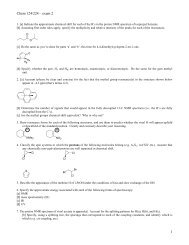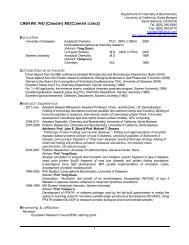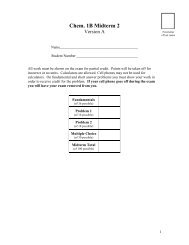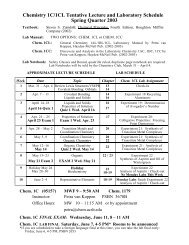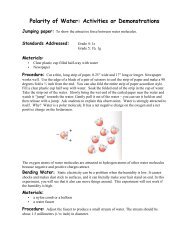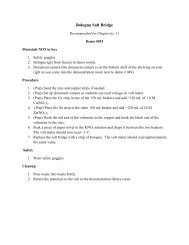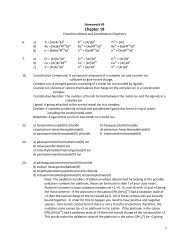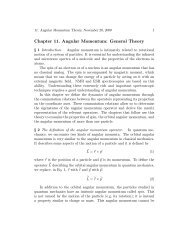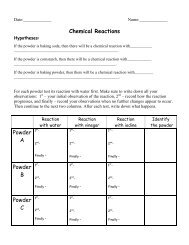Chapter 7. The Eigenvalue Problem
Chapter 7. The Eigenvalue Problem
Chapter 7. The Eigenvalue Problem
You also want an ePaper? Increase the reach of your titles
YUMPU automatically turns print PDFs into web optimized ePapers that Google loves.
<strong>7.</strong> <strong>The</strong> <strong>Eigenvalue</strong> <strong>Problem</strong>, December 17, 2009 29<br />
Remember that if U ij is a matrix element, the first index (here, i) labelsthe<br />
rows and the second index labels the columns. A simple way to construct U<br />
accordingtoEq.152istotakethefirst eigenvector of Ĥ and use it as the<br />
first column in U, then use the second eigenvector as the second column of<br />
U, etc.<br />
To construct U, we need to solve the eigenvalue problem for H. Because<br />
of this, constructing U is not a shortcut for finding the eigenvectors (from<br />
Eq. 145) or the eigenvalues (from Eq. 143). <strong>The</strong> theorem is however very<br />
useful for simplifying some equations and as an intermediate step in some<br />
mathematical proofs.<br />
In Section 4, Cells 6—7, of the file linear algebra for quantum mechanics.nb,<br />
I give an example of the construction of a unitary matrix U that diagonalizes<br />
a Hermitian matrix M. In the following displays, the numbers have been<br />
rounded to two significant digits.<br />
⎛<br />
M = ⎜<br />
⎝<br />
−1.1 2.3+0.022i −0.67 + 3.0i −3.5+5.0i<br />
2.3 − 0.022i −2.0 4.2+3.9i −1.1+3.1i<br />
−0.67 − 3.0i 4.2 − 3.9i 0.27 −2.5+4.6i<br />
−3.5 − 5.0i −1.1 − 3.1i −2.5 − 4.6i 1.2<br />
⎞<br />
⎟<br />
⎠ (153)<br />
<strong>The</strong> eigenvectors are (see Cell 7 of linear algebra for quantum mechanics.nb)<br />
x(1) = {−0.33 + 0.26i, −0.26 + 0.34i, −0.024 + 0.53i, 0.60} (154)<br />
x(2) = {−0.25 + 0.42i, 0.40 + 0.18i, −0.50 + 0.26i, −0.50} (155)<br />
x(3) = {−0.026 − 0.50i, 0.74 + 0.024i, −0.16 + 0.11i, 0.41} (156)<br />
x(4) = {−0.18 − 0.54i, −0.12 + 0.26i, 0.36 + 0.49i, −0.47} (157)<br />
Construct U by using the eigenvectors as columns:<br />
⎛<br />
⎞<br />
−0.33 + 0.26i −0.25 + 0.42i −0.026 − 0.50i −0.18 − 0.54i<br />
−0.26 + 0.34i 0.40 + 0.18i 0.74 + 0.024i −0.12 + 0.26i<br />
U = ⎜<br />
⎟<br />
⎝ −0.024 + 0.53i −0.50 + 0.26i −0.16 + 0.11 i 0.36 + 0.49 i ⎠<br />
0.60 −0.50 0.41 −0.47<br />
(158)<br />
We calculate that (see linear algebra for quantum mechanics.nb)<br />
⎛<br />
⎞<br />
11.63 0 0 0<br />
U −1 0 −9.87 0 0<br />
MU = ⎜<br />
⎟ (159)<br />
⎝ 0 0 −4.16 0 ⎠<br />
0 0 0 0.77




